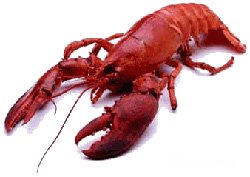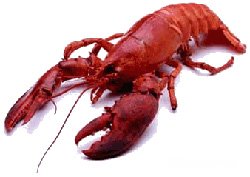Crayfish
Crayfish, often referred to as crayfish or crawdad, are freshwater crustaceans resembling small lobsters, to which they are closely related. They breathe through gills and are found in bodies of water, not frozen to the ground, they are also found mainly in brooks and streams where there is for fresh water and shelter from predators. Most crayfish can not tolerate polluted water, although some species such as invasive Procambarus clarkii, more hardy. Some crayfish have been found living on the depth of 3 meters (10 feet) underground.
In New Zealand the name crayfish (or cray) refers to the spiny lobster Sea, such as Jasus, who lives in much of southern Oceania. And crayfish are called freshwater crays or koura - name, upotrebyulyaemoe Maori for the animal. Science that studies the crayfish, called astakologiya.
Some kinds of crayfish are known locally as lobsters, crawdads, mudbugs and yabbies. In the Eastern United States, the name "crayfish" is more common in the north, while "crawdad" is characterized more in central and western regions, and again, "crawfish" further south.
Crayfish as a dish
 Crawfish is consumed in Europe, China, Australia and the United States. 98% of crayfish caught in the United States come from Louisiana, where the culinary standards are referred to as crayfish or ecrevisses. How to cook crabs yourself, click here.
Crawfish is consumed in Europe, China, Australia and the United States. 98% of crayfish caught in the United States come from Louisiana, where the culinary standards are referred to as crayfish or ecrevisses. How to cook crabs yourself, click here.
Crayfish served in Louisiana usually boiled alive in a large pot with heavy seasoning (salt, cayenne pepper, lemon, garlic, bay leaf, etc.) and other products such as potatoes, corn, onions, garlic, and sausage. These products are generally set used for the preparation of the crayfish. Other popular dishes of crawfish in Cajun and Creole cuisines of Louisiana include crawfish etouffee, crawfish pie, crawfish bread and crawfish from Besnier, in addition, crayfish - a component of chicken Marengo.
Crayfish - a popular dish in Scandinavia, and - according to tradition - primarily consumed during the fishing season in August. When cooking is usually added salt, sugar, beer and plenty of umbrellas dill. Capturing internal freshwater crayfish, Astacus astacus, and resettled the American species, Pacifastacus leniusculus, is very limited, and to meet the needs of consumption must be imported crawfish. For several decades, trade depended on imports from Turkey, but, after a decrease in supply, China and the United States today - the largest importers of crawfish.

Mexican crayfish locals call acocil, he was a very important source of food of the ancient Mexican Aztec culture, but now this type of crayfish is consumed (mainly boiled) and prepared with typically Mexican sauces or condiments in central and southern Mexico.
Dilution of the crayfish on the ferm
In many parts of the country in home gardens and horticultural cooperatives constructed ponds that are only used for watering gardens and orchards. But most of these reservoirs are good forage for crayfish. This is actually unprofitable water lands can be a source of good income families or members of the horticultural cooperatives, especially for those who do not know where to put your work. Breeding crayfish in the ponds can receive high-quality diet and a delicious meat, which contains 16% protein and 0.5% fat. Crayfish used in soups, sauces and salads. Boiled neck served as a garnish for fish dishes or beer. This suggests that the organization of the home farm for the breeding of crayfish in the ponds has a lot of sense, although the funds invested in their cultivation in the early years, will not bring much profit, as a serious income from the cultivation of crabs begins to enter the fourth and sixth year after first settlement of the pond. Nevertheless, it is advantageous and more profitable business for several decades after the settlement of crawfish ponds. To successfully grow crawfish in private households, it is necessary to know their biology and methods of cultivation in vitro.
Systematics and appearange crayfish
Within Russia crayfish are two kinds: the European (Astacus) and the Far East (Comaroid.es), three species and several subspecies, which differ little from the original forms and are unlikely to be raised to the degree of separate species. They, like other members of the order of decapod crustaceans (Decapoda), are aquatic animals, they breathe through gills and have five pairs of walking legs on cephalothorax. The body is covered with crayfish hard chitinous shell impregnated with calcium salts. The most extensive and important commercial value have European crayfish (Astacus), but residents of the Amur River Basin and Sakhalin Island, Far East can raise crayfish (Combaroides). European crayfish genus is represented in Russia by two species: shirokopalym (A. astacus) and long-toed (A. leptodactylus), which are spread almost all over Europe and western Siberia. Far Rhode cancers in our country before the Amur cancer (S. dauricus). The most valuable of the Russian crayfish is shirokopaly cancer, which is different from other kinds of wider and more powerful meaty claws, has a broad, fleshy belly (reach), which is a chef's and canning business called "crawfish." He lives mostly in waters belonging to the basin of the Baltic Sea, Latvia, Lithuania, Estonia, Leningrad region, in some regions of Ukraine and Belarus.
Distribution of long-toed, or uzkopalogo cancer is much broader and covers the rest of the space occupied by the European crayfish species. The claws of this species are thinner and longer than shirokopalogo cancer, they have less meat. The body shell is covered with cancer of the solid limestone shells (external skeleton). I clawed cancer usually occurs a sharp imbalance floors - the percentage of females does not rise above 35% in long-toed - the sex ratio is close, one by one. Therefore, the excess rate of yield is most clearly affects the population size clawed cancer. The critical signal-fishing is catch drop in efficiency to 50% of its initial value. On fertility of female cancer are much higher than long-toed clawed females. Thus, the absolute long-toed female fertility of cancer is 276 eggs, working - 193 eggs. In females, cancer clawed absolute fecundity - 50 eggs, labor - 30 eggs. Therefore, the extraction should withdraw only 25% of the adult population (carcinomas of more than 9 cm) shirokopalogo cancer. In some areas of Russia, Belarus and Ukraine due to the small number of crabs fishing is prohibited. These types of cancers in Europe will never inhabit the same body, and their ranges do not overlap. Biology of freshwater crayfish of different species is similar.
ECOLOGY. Crayfish in the wild live in a quiet running water, inhabiting rivers, streams, canals and large streams, lakes and ponds, and flowing from the shady shores, hiding in burrows, under driftwood or roots of large trees growing on the banks of the ponds. They breathe through gills intricate, but in a highly humid atmosphere can be a time to breathe as air. Crayfish are very demanding on the quality of water and its pollution or blooms leave such a body of water and move to one where they find favorable conditions. The most demanding environmental conditions shirokopaly cancer, so he usually lives in rivers, lakes and large ducts. Particularly demanding for crayfish in the water content of oxygen, which must be within the 5,4-9,1 mg / liter. They also do not tolerate very acidic environment, so the concentration of hydrogen ions in the water should be neutral or slightly alkaline in the extreme case (pHV 7-9). Optimum water temperature during the growth and reproduction of crayfish 17-18 ° C, although the adaptive capacity of adults is wider: 4-28 ° C. Degradation of water quality in the pond during the winter leads to complete loss of the population of crayfish. Therefore, when breeding these animals in the household farms should take special care to the quality of water flowing into the reservoir, especially at the coast, where the cottages and villages.
Shirokopaly cancer prefers sandy or rocky soil (limestone), so he rarely digs a hole, and as a refuge uses frequently snags or sitting under a stone. The water should contain many minerals, especially calcium ions (10-60 mg / l). In water, poor in minerals, in shell crabs becomes soft. Long-toed crayfish, unlike shirokopalyh are active all year, so can their winter fishing. They are more likely to live on soft clay soils and will hide in burrows dug into the cliffs of the rivers. Both species of crayfish have successfully adapted to life in water, suitable for breeding trout and whitefish, and are not eating their competitors, because trout live on floating feed, and crayfish eat it only on the bottom.




